Numerous rules govern fire protection in general automotive work as well as painting
Try to find the National Fire Protection Association’s code for auto body work—painting or not—and you’ll likely encounter NFPA 88B: Standard for Repair Garages. But NFPA dispensed with that standard nearly two decades ago. Today, those standards have migrated to NFPA 30A: Code for Motor Fuel Dispensing Facilities and Repair Garages.
There’s more than a single standard governing fire protection in automotive paint spray booths, however. In this article, we explain the fire suppression systems these standards require for paint and body shops, as well as the role of fire sprinklers in these facilities.
For those already looking to make a purchase, our selection of commercial fire sprinklers and sprinkler system components can help paint shops stay in compliance with fire code.
Two codes—NFPA 30A and NFPA 33—contain core requirements for paint booth fire suppression systems
Does NFPA 30A—a standard focused on safety when dispensing motor fuel—really apply to paint shops? For the answer, let’s look at NFPA 30A’s definition of a repair garage [emphasis ours]:
From the 2018 edition of NFPA 30A
3.3.12 Repair Garages.
3.3.12.1 Major Repair Garage. A building or portions of a building where major repairs, such as engine overhauls, painting, body and fender work, and repairs that require draining of the motor vehicle fuel tank are performed on motor vehicles, including associated floor space used for offices, parking, or showrooms.
NFPA 30A does cover paint shops under “major repair garages”—and what’s more, these provisions apply even in sections of these buildings, such as offices, that seem decidedly less likely to burn.
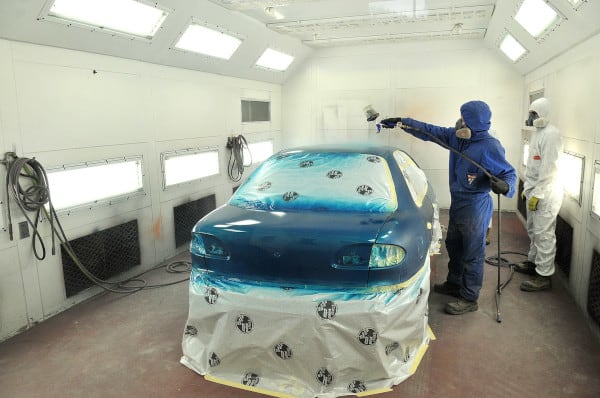
But one other standard also applies in automotive painting work: NFPA 33: Standard for Spray Application Using Flammable or Combustible Materials. The broad scope of the standard—which covers an impressive array of flammable or combustible materials—provides fire safety standards for all but a few types of paint spray booths. NFPA 33 doesn’t apply to:
- Operations that use less than a liter of flammable or combustible liquid in any 8-hour period (section 1.1.4)
- Processes conducted outdoors (1.1.6), as long as they aren’t conducted within a temporary membrane enclosure—a tent-like structure typically made from metal scaffolding with a plastic exterior (1.1.5)
- Portable spray equipment not used repeatedly in the same location (1.1.7)
- The use of aerosol products one liter in size or smaller, if they’re not used repeatedly in the same location (1.1.8)
However, none of this means that these smaller operations require no fire protection. NFPA’s building, life safety, and fire safety standards still apply, as well as any locally adopted versions of the International Building Code that have the force of law.
NFPA 30A helps installers determine required safety and fire suppression features in a variety of repair shops
NFPA 30A’s requirements for the construction of repair shops are contained in section 7.4. In it, each shop is classified as a “special-purpose industrial occupancy.” That classification, as explained in NFPA 101: Life Safety Code, covers industrial facilities with a low density of people, where “ordinary and low hazard” activities take place in places designed for a specific purpose. Using NFPA 101, fire safety experts can determine required design features, exit routes (the “means of egress”), emergency lighting, and more.
NFPA 30A requires automatic sprinklers throughout buildings containing three types of major repair garages in subsection 7.4.6:
- A garage housed in a building with two or more stories when its size exceeds 10,000 square feet. Note that “stories” include basements.
- Single-story garages exceeding 12,000 square feet.
- Garages servicing vehicles parked in the building’s basement.
If the building services hydrogen-powered vehicles, NFPA 2: Hydrogen Technologies Code also applies (section 7.1.1 and 7.1.2). Other standards will need to be considered in facilities that also service vehicles fueled with hydrogen, compressed or liquefied natural gas, or liquefied petroleum gas (7.4.2).
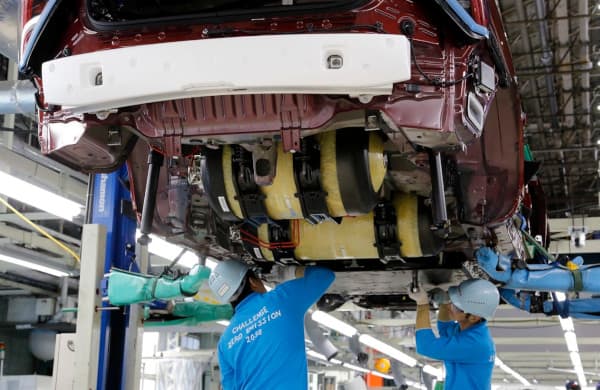
While we’ll focus on fire suppression systems in this article, it’s worth noting that this code has several other prescriptions. NFPA 30A also addresses the paint or repair shop’s:
- Means of egress
- Drainage
- Pits and below-grade/subfloor work areas
- Gas-detection systems
- Heating, ventilation, and air conditioning
- Heat-producing appliances
- Emissions-testing equipment
NFPA 33 defines the sorts of structures where paint can be sprayed
NFPA 30A focuses on safeguards needed in buildings dispensing liquid and gaseous motor fuels—a likely scenario for many paint and body shops. NFPA 33, on the other hand, covers any kind of painting where liquids that easily catch fire are sprayed.
In section 4.1, NFPA 33 restricts spray operations to four kinds of structures:
- A spray area. NFPA 33’s broadest term for these structures describes areas “in which flammable or combustible vapors, mists, residues, dusts, or deposits are present due to the operation of spray processes” (3.3.2.3). The interiors of a spray booth, spray room, or limited finishing workstation are included, as are several supporting HVAC and production features.
- Spray booths and spray rooms. The latter is fully enclosed with specific fire-rated materials, while the former merely “confines and limits the escape of the material being sprayed” (3.3.18, 3.3.19). Both feature powered ventilation.
- A temporary membrane enclosure. This structure exists only for a short period of time—180 days or less—and features an exterior made of material designed to fall apart in the event of a fire, allowing sprinklers above the membrane to activate.
- Spray areas also encompass limited finishing workstations, which have powered ventilation (3.3.21.1), along with noncombustible or limited-combustible curtains or partitions (14.3.2). These workstations aren’t spray booths or spray rooms, rather facilities that can confine vapors generated in the course of limited use—no more than one gallon of material may be sprayed in any eight-hour period.
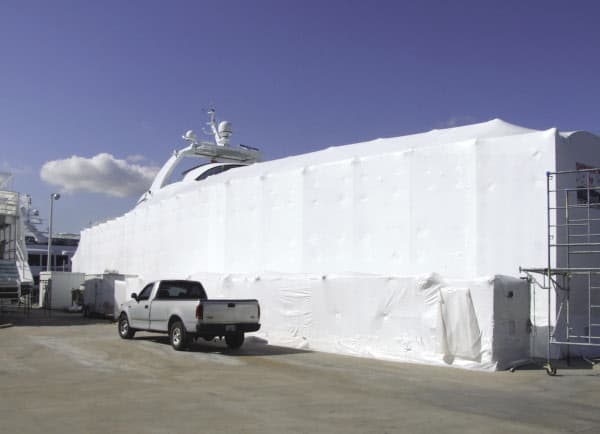
When sprinkler systems are used to protect against paint spray fires, special attention to the type of system is warranted
For spray booths, spray rooms, temporary membrane enclosures, and other spray areas, NFPA 33 requires some form of automatic fire protection. Installers have six options, listed in subsection 9.1.3 along with the relevant NFPA codes:
- A fire sprinkler system (NFPA 13)
- A foam sprinkler system (NFPA 16)
- A carbon dioxide system (NFPA 12)
- A dry chemical system (NFPA 17)
- A gaseous agent system (NFPA 2001)
- A water mist fire protection system (NFPA 750)
Section 9.6.1 allows for the use of any of the four major fire sprinkler system types: wet pipe, dry pipe, preaction, or deluge. However, these systems are not all equally suited to all spray area hazards.
For an introduction to these systems, read “Fire Sprinkler Systems: History, Types, and Uses.”
Fire protection systems for paint spray must account for ventilation, application methods, ambient temperatures, and other factors. For example, electrostatic spray carries the risk of a fire igniting through static discharge. But this process uses electrical charges in the paint and the surface to produce an even, well-bonded coat, making it a popular choice in paint shops and among manufacturers such as BMW:
In section A.9.6.1, NFPA 33 explains when a given sprinkler system type is best used:
- Open-head deluge systems provide the most protection. When properly designed, all heads in these systems flow water simultaneously. This total coverage makes deluge systems the best choice for “large, downdraft, water-wash spray booths when protecting automatic electrostatic spray application zones.”
- Wet-pipe systems can protect spray booths that use nonelectrostatic processes or listed electrostatic application processes, as well as ducts, plenums, and other ventilation equipment.
- Preaction systems best serve areas with equipment that would be damaged by water, such as powder spray booths.
- Dry pipe systems can protect exhaust ducts that have sections that may freeze.
Sprinklered for moderate to severe risks, spray areas must also meet painting-specific requirements
With only two exceptions, sprinklers for spray systems must be designed for Extra Hazard (Group 2) occupancies (NFPA 33 9.6.2). Those exceptions—which are designed for Ordinary Hazard (Group 2)—are:
- Spray application of styrene cross-link thermoset resin application areas
- Powder coating operations
These terms come from chapter 4 of NFPA 13: Standard for the Installation of Sprinkler Systems. Ordinary Hazard (Group 2) occupancies are sprinklered as if the space contains contents of “moderate to high quantity and combustibility.” Extra Hazard (Group 2) occupancies—one of the most extreme categories in NFPA 13—covers spaces with high quantities of materials and liquids that burn very easily. In short, most paint spray operations are sprinklered as if they are extremely hazardous.
These systems must have enough water to supply all sprinklers without exhausting the water available for firefighters’ hose streams (NFPA 33, 9.6.3). A domestic water supply may be used if it can meet these requirements—but only when sprinklers only protect spray areas and mixing rooms (9.6.4).
One other important note: sprinklers in these areas require protection from overspray, and must be replaced if painted or coated (9.6.7, 9.6.7.2). That protection may consist only of thin cellophane bags—no more than 0.003 inches thick—which must be replaced before heavy deposits of residue build up (9.6.7.1).
Sprinklered duct protection in NFPA 33 covers manifolds, exhaust, and more
Fires can spread quickly from ducts to painting areas, and vice versa. The bulk of NFPA 33’s requirements for duct sprinkler systems apply only to stacks or ducts with widths or diameters between 10 inches and 12 feet in width or diameter (9.6.6). They include:
- Protection at vertical risers and offsets. All vertical risers need a sprinkler at the top. Offsets need a sprinkler at the midpoint. If the rise exceeds 24 feet, more sprinklers must be placed at 24-foot centers.
- Heads for horizontal exhaust ducts placed at 12-foot centers. The sprinkler nearest the duct entrance must be no more than six feet away.
- Extra protection for manifolded ducts: one sprinkler at each junction between the duct and the manifold.
- Minimum flow requirements: each duct and stack sprinkler must provide at least 30 gallons per minute at 15 pounds per square inch.
- Specific sprinkler temperature ratings. Sprinklers’ activation temperature must be at least 50 degrees Fahrenheit above the duct’s operating temperature. But sprinklers must be rated for ordinary temperatures when duct temperatures allow it.
- System demand requirements. “The system demand shall include the discharge from the hydraulically most remote adjacent sprinklers in a common 30.5 m (100 linear ft) area of duct (horizontal and/or vertical).” In other words: designers must provide enough water to serve the parts of the ductwork that are the most challenging for the fire sprinkler system to protect (within a 100-linear-foot region).
- Sprinklers supplied from ceiling pipes must have their own listed control valve on the supply line.
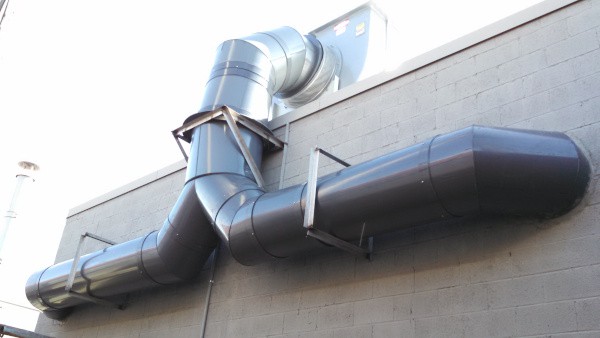
All ductwork sprinkler systems require access openings for inspection and maintenance (9.6.6.1). Further, when ducts are subject to freezing, manually operated open-head systems, as well as non-freeze or dry-type automatic sprinklers, are an option (9.6.6.2).
Find the right sprinkler for your wet-pipe, dry, or preaction paint booth sprinkler system
Fire suppression in automotive paint booths is a surprisingly detailed topic that reaches into several volumes of code. We’ve only scratched the surface: other automatic fire suppression systems, fire extinguishers, and the finer points of some paint applications deserve a closer look. But with an understanding of the codes introduced here, and a strong grasp of the processes used by a given paint and body shop, it’s possible to keep a facility safe and code-compliant.
Looking for products for your paint spray application? QRFS carries a variety of commercial fire sprinklers with the low-temperature ratings desired for most paint spray applications, as well as temperature ratings for ducts and other hot areas.
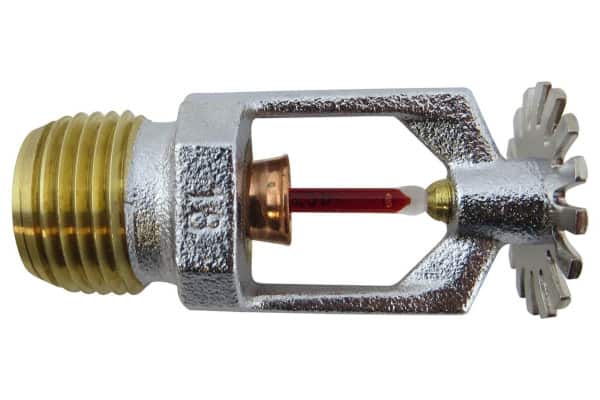
For duct protection in above-freezing areas, as well as protection for nonelectrostatic (and listed electrostatic) spray processes, browse our selection of commercial fire sprinklers and sprinkler system components.
QRFS also offers a range of dry sprinkler heads available on special order. Simply give us a call at 888.361.6662 or email support@qrfs.com.
This blog was originally posted at blog.qrfs.com. Check us out at Facebook.com/QuickResponseFireSupply or on Twitter @QuickResponseFS.


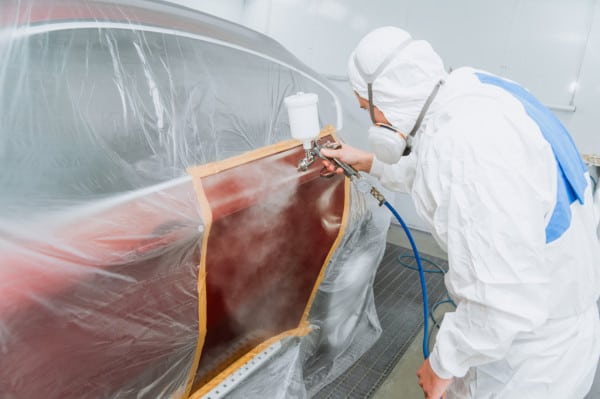
What is your take on protecting the pit and tunnel on a downdraft spray booth utilizing water base fire protection?
Darryl — thanks for reaching out. For system application questions like this, we recommend submitting your question through QRFS Ask A Fire Pro. Click the link to submit your question with some information about your building or system, and a fire protection professional will provide a detailed answer based on standards and codes. Our pros include AHJs, contractors, engineers, and code experts with 150+ years of combined experience!